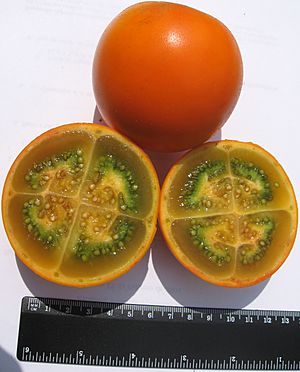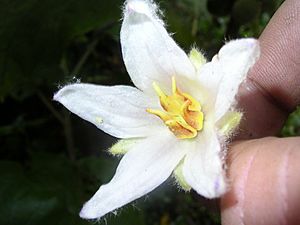Solanum quitoense facts for kids
Quick facts for kids Solanum quitoense |
|
|---|---|
 |
|
| Whole and transversely-cut fruit | |
| Scientific classification | |
| Genus: |
Solanum
|
| Species: |
quitoense
|
The Naranjilla (pronounced nah-rahn-HEE-yah) is a cool fruit from South America. People in countries like Ecuador, Costa Rica, and Panama call it Naranjilla, which means "little orange." In Colombia, it's known as Lulo (pronounced LOO-loh).
This plant, scientifically called Solanum quitoense, grows in warm, tropical places. It's a perennial plant, meaning it lives for more than two years. The name quitoense tells us it comes from Quito, a city in Ecuador.
The lulo plant is quite pretty. It has big, heart-shaped or oval leaves that can be up to 45 centimeters (about 18 inches) long. Both the leaves and stems are covered in soft, short purple hairs. Naranjilla plants are a bit sensitive. They need protection from strong winds and too much sun. They grow best where there is some shade.
The fruit itself tastes like a mix of citrus fruits. Some people say it's like a blend of rhubarb and lime. The juice from a naranjilla is a bright green color. It's often used to make refreshing drinks, like a popular Colombian beverage called lulada.
Growing Naranjilla Plants
Naranjilla is a special fruit that many people around the world would like to try. It has been suggested as a new flavor for the food industry. However, growing naranjilla plants on a very large scale is difficult. This makes it harder for the fruit to become widely available.
Harvesting the Fruit
Just like tomatoes, naranjilla fruits can get damaged easily when they are fully ripe. Because of this, farmers usually pick them before they are completely ripe. You can often find these fruits for sale in local markets. People who live in these areas often enjoy making drinks by adding sugar and water to the freshly squeezed fruit juice. It's a simple and tasty way to enjoy the naranjilla.
Images for kids
See also
 In Spanish: Lulo para niños
In Spanish: Lulo para niños








